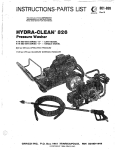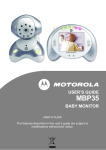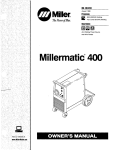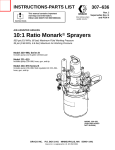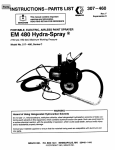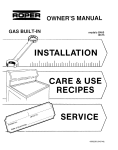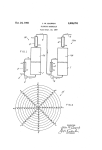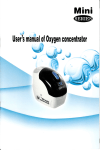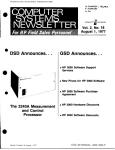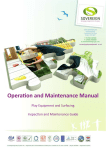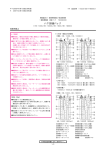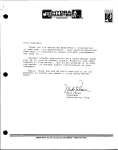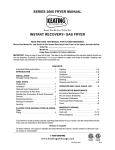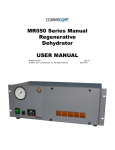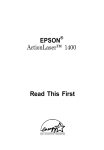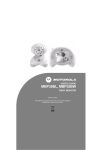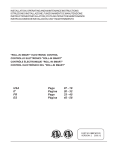Download Graco AA2000 User's Manual
Transcript
INSTRUCTIONS-PARTS LIST This manual contains important Model AA2000 High Efficiency Low Pressure” Air-Assisted Part Number 222-615, System Airless Spray Gun Series C 950 psi (66 bar) Maximum Working Fluid Pressure 100 psi (7 bar) Maximum Working Air Pressure * 10 psi (0.7 bar) Maximum Operating Air Pressure** * The Maximum Workina Air Pressurq indicates the maximum air pressure the gun was designed to operate safely under. **The /&@num Operating Air Pressure indicates the maximum air pressure the air cap supplied with this gun was designed to operate at or below to comply with California Wood Rule 7736. To guarantee compliance to rule 1136, the gun must be used with Air Regulator Part No. 110-776. This regulator limits the operating pressure to 10 psi (0.7 bar), using an air supply pressure of 100 psi (7 bar). U.S. Patent Nos. 3843,052; 4,386,739 United Kingdom Patent No. 2 111 406 B Patented 1984 Canada Brevete 1984 French Patent No. 82-21202 Foreign Patents Pending GRACO INC. P.O.BOX 1441 MINNEAPOLIS, MN 55440-1441 OCOPYRIGHT 1988, GRACO INC. Table of Contents SafetyWarnings ............................... 3 Installation Ventilate the Spray Booth ..................... Required Accessories ........................ Connect the Air Line ......................... Connect the Fluid Line ....................... Grounding .................................. 6 6 7 7 7 Operation How Air-Assisted Airless Spray Gun Operates ... 7 Select A Spray Tip ........................... 8 Install a Spray Tip ............................ 8 Adjust the Spray Pattern and Apply the Fluid .... 8 Flush the Gun Daily ......................... 10 Clean the Spray Gun and System Daily ........ 10 2 307-947 Troubleshooting .............................. 11 Service Air Valve Service ............................ Fluid Packing Replacement .................. 12 12 Parts ........................................ 14 Optional Parts ............................... 15 Accessories ................................. 16 Spray Tip Selection Charts .................... 18 Technical Data ............................... 19 Dimensions .................................. 19 Warranty ............................ Back Cover WARNINGS High Pressure Spray Can Cause Serious Injury. For Professional Use Only. Observe All Warnings. Read and understand all instruction manuals before operating equipment. FLUID INJECTION HAZARD General Safety This equipment generates very high fluid pressure. Spray from the gun, leaks or ruptured components can inject fluid through your skin and into your body and cause extremely serious injury, including the need for amputation. Also, fluid injected or splashed into the eyes or on the skin can cause serious damage. Never point the spray gun at anyone or at any part of the body. Never put hand or fingers over the spray tip. Never try to stop or deflect leaks with your hand or body. Never try to “blow back” paint; this is not an air spray gun. Always follow the Pressure Relief Procedure, at right, before cleaning or removing the spray tip or servicing any system equipment. Check operation of all equipment safety devices before each use. Medical Alert - Airless Spray Wounds If any fluid appears to penetrate your skin, get emergency medical care at once. Do not treat as a simple cut. Tell the doctor exactly what fluid was injected. NOTE TO PHYSICIAN: Injection into the skin is a traumatic injury. It is important to treat the injury surgically as soon as possible. Do not delay treatment to research toxicity. Toxicity is a concern with some exotic coatings injected directly into the blood stream. Consultation with a plastic surgeon or reconstructive hand surgeon may be advisable. Spray Gun Safety Devices Be sure all gun safety devices are operating properly before each use. Do not remove or modify any part of the gun; this can cause a malfunction and result in serious injury. Safefy Latch Whenever you stop spraying, even for a moment, always set the gun safety latch in the closed or “on safe” position, making the gun inoperative. See Fig. 3, page 8. Failure to set the safety latch can result in accidental triggering of the gun. Diffuser The gun diffuser breaks up spray and reduces the risk of fluid injection when the tip is not installed. Check diffuser operation regularly. Follow the Pressure Relief Procedure, below, then remove the spray tip. Aim the gun into a grounded metal pail, holding the gun firmly to the pail. Using the lowest possible pressure, trigger the gun. If the fluid emitted is not diffused into an irregular stream, replace the diffuser immediately. Spray Tip Safety Use extreme caution when cleaning or changing spray tips. If the spray tip clogs while spraying, engage the gun safety latch immediately. Always follow the Pressure Relief Procedure, below, and then remove the spray tip to clean it, Never wipe off build-up around the spray tip or air cap until pressure is fully relieved and the gun safety latch is engaged. Pressure Relief Procedure To reduce the risk of serious injury, including fluid injection, splashing in the eyes or on skin, or injury from moving parts, always follow this procedure whenever pump is shut off, when checking or servicing any part of system, when installing or changing spray tips and whenever you stop spraying. 1. Engage the spray gun safety latch. Shut off the power to the pump. 3. Close the bleed-type master air valve (required in system). 4. Disengage the gun safety latch. 5. Hold a metal part of gun firmly to the side of a grounded metal container and trigger the gun to relieve fluid pressure. 6. Engage the gun safety latch again. 7. Open pump drain valve (required in system)to help relieve fluid pressure in the displacement pump. In addition, open the drain valve connected to the fluid pressure gauge (in a system with fluid regulation) to help relieve fluid pressure in the hose and gun. Triggering the gun to relieve pressure may not be sufficient. Have a container ready to catch the drainage. 8. Leave drain valve(s) open until you are ready to spray again. If you suspect that the spray tip or hose is completely clogged or that pressure has not been fully relieved after following the steps above, very slowly loosen the hose end coupling and relieve pressure gradually, then loosen completely. Now clear the tip or hose obstruction. 2. 307-947 3 Static electricity is created by the flow of fluid through the pump and hose. If every part of the equipment is not properly grounded, sparking may occur, and the system may become hazardous. Sparks can ignite fumes from solvents and the fluid being sprayed, dust particles and other flammable substances, whether you are pumping indoors or outdoors, and cause a fire or explosion, serious injury, and property damage. Sparks may also occur when plugging in or unplugging a power supply cord. Do not plug in or unplug any power supply cords in the spray area when there is any chance of igniting fumes still in the air. If you experience any static sparking or feel even a slight shock while using this equipment, stop spray ing immediately. Check for proper grounding of the entire system. Do not use the system again until the cause of the problem is identified and corrected. Grounding To reduce the risk of static sparking, ground the pump and all other equipment used or located in the spray area. Check your local electrical code for detailed grounding instructions for your area and type of equipment and be sure to ground all of the following equipment: 1. Pump: use a ground wire and clamp as instructed in your separate pump instruction manual. 2. Air, fluid, and hydraulic hoses connected to the pump: use only grounded hoses with a maximum of 500 feet (150 m) combined hose length to ensure grounding continuity. Refer also to Hose Grounding Continuity, below. Air compressors and hydraulic power supplies: ground according to the manufacturer’s recommendations. 4. Spray gun: obtain grounding through connection to a properly grounded fluid hose and pump. 5. Fluid suppfy container: according to local code. 6. Object being sprayed: according to local code. 7. All solvent pails used when flushing, according to local code. Use only metal pails, which are conductive. Do not place the pail on a non-conductive surface, such as paper or cardboard, which interrupts the grounding continuity. 8. To maintain grounding continuity when flushing or relieving pressure, always hold a metal part of the gun firmly to the side of a grounded metal pail, then trigger the gun. Flushing Safety To reduce the risk of fluid injection injury, static sparking, or splashing, follow the Pressure Relief Procedure on page 3, and remove the spray tip before flushing. Hold a metal part of the gun firmly to the side of a grounded metal pail and use the lowest possible fluid pressure during flushing. Ventilate the Spray Booth To prevent hazardous concentrations of toxic and/or flammable vapors, spray only in a properly ventilated spray booth. Never operate the spray gun unless the ventilating fans are operating. HOSE SAFETY High pressure fluid in the hoses can be very dangerous. If the hose develops a leak, split or rupture due to any kind of wear, damage or misuse, the high pressure spray emitted from it can cause a fluid injection injury or other serious injury or property damage. All fluid spray hoses must have a spring guard on both ends! The spring guards help protect the hose from kinks or bends at or close to the coupling which can result in hose rupture. Tighten all fluid connections securely before each use. High pressure fluid can dislodge a loose coupling or allow high pressure spray to be emitted from the coupling. Never use a damaged hose. Before each use, check the entire hose for cuts, leaks, abrasion, bulging cover, or damage or movement of the hose couplings. If any of these conditions exist, replace the hose immediately. Do not try to recouple high pressure hose or mend it with tape or any other device. A repaired hose cannot contain the high pressure fluid. 4 307-947 Handle and route hoses carefully. Do not pull on hoses to move equipment. Do not use fluids or solvents which are not compatible with the inner tube and cover of the hose. Do not expose Grace hose to temperatures above 180” F (82” C) or below -40” F (-40” C). Hose Grounding Continuity Proper hose grounding continuity is essential to maintaining a grounded spray system. Check the electrical resistance of your air and fluid hoses at least once a week. If your hose does not have a tag on it which specifies the maximum electrical resistance, contact the hose supplier or manufacturer for the maximum resistance limits. Use a resistance meter in the appropriate range for your hose to check the resistance. If the resistance exceeds the recommended limits, replace it immediately. An ungrounded or poorly grounded hose can make your system hazardous. Also read FIRE OR EXPLOSION HAZARD. General Safety Any misuse of the equipment or accessories, such as overpressurizing, modifying parts, using incompatible chemicals and fluids, or using worn or damaged parts, can cause them to rupture and result in serious injury, including fluid injection and splashing fluid in the eyes or on the skin, or in fire, explosion or property damage. System Pressure The High Efficiency Low Pressure System 2500 AA2000 spray gun has a 950 psi (66 bar) Maximum Fluid Working Pressure and 100 psi (7 bar) Maximum Working Air Pressure (indicates the maximum air pressure the gun was designed to operate safely under). Never exceed these pressures! Never alter or modify any part of this equipment; doing so could cause it to malfunction. The Maximum Operating Air Pressure is 10 psi (0.7 bar). This indicates the maximum air pressure the air cap supplied with this gun was designed to operate at or below to comply with California Wood Rule 1136. To guarantee compliance to rule 1136, the gun must be used with Air Regulator Part No. 11O-776. This regulator limits the operating pressure to 10 psi (0.7 bar), using an air supply pressure of 100 psi (7 bar). Check the gun and all spray equipment regularly and repair or replace worn or damaged parts immediately. Read and follow the fluid and solvent manufacturer’s literature regarding the use of protective eyewear, gloves, clothing, respirator and other equipment. Fluid Compatibility Be sure all fluids and solvents used are chemically compatible with the “Wetted Parts” shown in the Technical Data on page 19. Always read the fluid and solvent manufacturer’s literature before using them in this gun. Be sure that all spray equipment and accessories added to the spray system are properly rated to withstand the maximum working pressure of your system. Do not exceed maximum working pressure of any component or accessory used in the system. IMPORTANT UnitedStatesGovernmentsafetystandardshavebeenadoptedunderthe OccupationalSafetyand HealthAct. Thesestandardsparticularlythe GeneralStandards,Part 1910,and the ConstructionStandards,Part 1926 - should be consulted. 307-947 5 Installation KEY A B C D E F Gun Air Inlet Gun Fluid Inlet Bleed-Type Master Air Valve Main Air Supply Line Pump Air Regulator Gun Air Regulator, p/n 110-776, 10 psi (0.7 bar)Maximum Outlet Pressure G Pump Ground Wire H Air Line Filter J Fluid Drain Valve K Gun Air Hose L Gun Fluid Hose M Fluid Regulator Kit N Fluid Filter P Air Pressure Relief Valve Fig. 1 shown in Fig.1 is only a guide The typical installation for selecting and installing air-assisted airless spray systems. It is not an actual system design. Contact your Grace representative for assistance in designing a system to meet your needs. The Grace fluid pump Model 217-523 is designed for use in air-assisted airless systems. It has a maximum working pressure of 950 psi (66 bar). See instruction manual 307-595 for information on this pump. Ventilate the Spray Booth WARNING To prevent hazardous concentrations of toxic and/ or flammable vapors, spray only in a properly ventilated spray booth. Never operate the spray gun unless ventilation fans are operating. Check and follow all of the National, State and Local codes regarding air exhaust velocity requirements. 6 307-947 Required Accessories WARNING Two accessories, the bleed-type master air valve (C), and the fluid drain valve (J) are required for your system to reduce the risk of serious injury from moving parts, splashing, or fluid injection when shutting off the pump. The bleed-type master air valve (located downstream of the pump air regulator) relieves air trapped between the valve and the pump, after the pump is shut off. Trapped air can cause the pump to cycle unexpectedly and result in serious injury if you are adjusting or repairing the pump. The fluid drain valve(s) helps relieve fluid pressure in the displacement pump, hose and gun when shutting off the pump. Triggering the gun to relieve pressure may not be sufficient, especially if there is a clog in the hose, gun, or tip. Installation Connect the Air Line Install fluid drain valve(s) (J) to help relieve fluid pressure. Install an air line filter (H) to ensure a clean, dry air supply to the gun. Dirt and moisture in the line can ruin the appearance of your finished piece. NOTE: The gun fluid connector (6) has a l/4-18 npsm (Rl/4- 19) compound male thread that is compatible with NPSM and BSP female connectors. Install Air Pressure Regulator 1lo-776 (F) to control the air pressure to the gun and limit it to 10 psi (0.7 bar) Maximum Operating Air Pressure. Install a bleed-type master air valve (C) on the main air line. Install a bleed-type master air valve or air pressure relief valve (P), which is easily accessible from the pump and downstream from the pump air regulator (E). Install an in-line fluid filter (see part no. 210-500 in the Accessories section) on the gun fluid connector (B) to avoid clogging the spray tip with particles from your fluid. NOTE: The gun air inlet has a l/4-1 8 npsm @1/4-l 9) compound male thread that is compatible with NPSM and BSP female swivel connectors. Connect the grounded fluid hose (L) to the gun fluid connector (B) or optional in-line filter. Connect the air hose (K) from the air supply to the gun air inlet. Grounding Connect the Fluid Line WARNING To reduce the risk of serious injury, be sure your entire system is properly grounded. Read FIRE AND EXPLOSION HAZARD on page 4. The gun is grounded by connecting it to a properly grounded pump and hose. Install a fluid pressure regulator (M) to control fluid pressure to the gun. Some applications require fine-tuned control of fluid pressure. You can control fluid pressure more accurately with a fluid pressure regulator than by regulating the air pressure to the w-v. Operation The spray gun has a built-in lead and lag operation. When triggered, the gun begins emitting air before the fluid is discharged. When the trigger is released, the fluid stops before the air flow stops. This helps assure the spray is atomized and prevents fluid buildup on the air cap. WARNING The wallet sized warning card 179-960, provided with the gun, should be available and easily accessible at all times for anyone operating or servicing this equipment. The card contains important information on what to do if a fluid injection injury occurs. Additional cards are available at no charge from Grace. I How the Air-Assisted Airless Spray Gun Operates The air-assisted airless gun combines airless and air spraying concepts. The spray tip shapes the fluid into a fan pattern, similar to a conventional airless spray tip, but at a lower pressure. Air from the air cap further atomizes the fluid and completes the atomization of the paint tails into the pattern. The pattern adjustment valve controls the width of the pattern. 1 Note that the air-assisted airless spray gun differs from an air spray gun in that increasing the pattern air reduces the pattern width. To increase the pattern width, less pattern air or a larger size tip must be used. Remember, this is not an air spray gun; for your safety be sure to read and follow the Warnings on pages 3 to 5 and throughout the text of thus 307-947 7 Operation Select a Spray Tip Horizontal Spray Pattern Vertical Spray Pattern Use the Spray Tip Selection charts on page 18, as a guide for selecting an appropriate spray tip for your application. The fluid output and pattern width depend on the size of the spray tip, the fluid viscosity, and the fluid pressure. NOTE: When spraying very low viscosity fluids, use the optional fluid needle 220-413 (see page 15). The standard needle may not provide positive shut off for such fluids. Install a Spray Tip To reduce the risk of a fluid injection injury, Always Pattern ki~gtment before removing or installing a spray tip. Install a spray tip in the gun. The air cap and spray tip position determines the direction of the spray pattern. Safety Latch Disengaged or in OFF SAFE Position Rotate the air cap (the spray tip rotates with it) as needed for the desired spray pattern direction. See Fig. 2. Adjust the Spray Pattern & Apply the Fluid WARNING To reduce the risk of serious injury, including fluid injection, and splashing in the eyes or on the skin: 1. Never point the spray gun at anyone or any part of the body or put your hand or fingers over the spray tip when adjusting the spray pattern or spraying fluid. 2. Always engage the trigger safety latch when you stop spraying. See Fig. 3. Safety Latch Engaged or in ON SAFE Position ::$2 ; ,: .,,. ......:::.:;ri: :..I .. ,.:., 3. Never exceed the maximum air and fluid working pressure of the lowest rated component in your system. See System Pressure in the EQUIPMENT MISUSE HAZARD Section on page 5. 1. Set the fluid pressure at 300 psi (21 bar). 2. Trigger the gun to check the atomization: do not be concerned about the pattern shape yet. 8 307-947 i ..... No Air Too Little Air Right Amount of Air Operation Adjust the Spray Pattern & Apply the Fluid (Continued’ 1. Increase the fluid pressure just to the point where a further increase in fluid pressure does not significantly improve fluid atomization. Do not exceed 950 psi (66 bar) fluid pressure to the gun. 4. When applying the fluid, keep the gun a consistant distance, 8 to 10 inches (200 to 250 mm), from the surface of the object being sprayed. Always hold the gun at a right angle from the surface. Do not make an arc with the gun as it causes an uneven coat of fluid. See Fig. 5. 2. Close the pattern adjustment valve by turning the knob (see Fig. 3) counterclockwise all the way. This sets the gun for its widest pattern 3. Set the atomizing air pressure at about 5 psi (0.35 bar). Check the spray pattern, then adjust the air pressure until all the tails are completely atomized and pulled into the spray pattern. See Fig. 4. RIGHT NOTE: Do not exceed 10 psi (0.7 bar) air pressure to the gun. The air cap supplied with this gun was designed to operate at or below 10 psi (0.7 bar) air pressure to comply with California Wood Rule 1136. For a narrower pattern, turn the pattern adjust- ment valve knob clockwise. If the pattern is still not narrow enough, increase the air pressure to the gun slightly or use a different size tip. NOTE: For some spray tips, when the line air pressure to the gun is increased to a certain level, the spray pattern will become round. This is the smallest pattern width. Further increases in air pressure will force the pattern to turn from horizontal to vertical or from vertical to horizontal. WRONG 0793 307-947 9 Operation Flush the Gun Daily WARNING Dressure Relief Procedure Toreduce the risk of serious injury, including fluid njection, splashing in the eyes or on skin, or injury ‘ram moving parts, always follow this procedure Nhenever the pump is shut off, when checking or servicing any part of the system, when installing or :hanging spray tips and whenever you stop spraying. 1. Engage the spray gun safety latch. 2. Shut off the power to the pump. 3. Close the bleed-type master air valve (required in system). 4. Disengage the gun safety latch. 5. Hold a metal part of the gun firmly to the side of a grounded metal waste container and trigger the gun to relieve fluid pressure. 6. Engage the gun safety latch again. 7. Open the pump drain valve (required in system) to help relieve fluid pressure in the displacement pump. In addition, open the drain valve connected to the fluid pressure gauge (in a system with fluid regulation) to help relieve fluid pressure in the hose and gun. Triggering the gun to relieve pressure may not be sufficient. Have a container ready to catch the drainage. 8. Leave the drain valve(s) open until you are ready to spray again. If you suspect that the spray tip or hose is completely clogged or that pressure has not been fully relieved after following the steps above, very slowly loosen the hose end coupling and relieve pressure gradually, then loosen completely. Now clear the tip or hose obstruction. 1. Follow the Pressure Relief Procedure Warning, above. 2. Disconnect the atomizing air hose and the fluid supply line. 5. Hold a metal part of the gun firmly against a grounded metal waste container and trigger the gun until all traces of paint are removed from the gun passages. See Fig. 6. 6. Follow the Pressure Relief Procedure Warning at left. 7. Disconnect the solvent supply. Clean the Spray Gun & System Daily CAUTION Never immerse the gun in solvent. Doing so can damage packings and allow solvent in the air passages, which can cause poor atomization and gun Do not use metal tools to clean holes in the air cap or spray tip. Metal instruments may damage holes and distort the spray pattern. 1. Follow the Pressure Relief Procedure Warning at left. 2. Clean the outside of the gun with a soft cloth dampened with compatible solvent. 3. If using an in-line filter, remove and clean it thoroughly in a compatible solvent. 4. To avoid damaging the spray tip and air cap, clean them with a compatible solvent and soft brush. To clean the air cap passages, use a soft brush or other soft tool, with an air blow gun. 5. Clean the system’s fluid filter and air line filter. Ground Wire 3. Remove the spray tip. 4. Connect the solvent supply to the gun. When flushing or relieving pressure, maintain firm metal-to-metal contact between the gun and a grounded metal container CAUTION Be sure the solvent is compatible with the fluid being sprayed to avoid clogging the gun’s fluid passages. 10 307-947 Fig. 6 Troubleshooting I WARNING To reduce the risk of serious injury, including fluid injection, splashing fluid or solvent in the eyes or on the skin, or injury from moving parts, always follow the Pressure Relief Procedure Warning on page 10 whenever you shut off the pump, when checking or servicing any part of the spray system, when installing, cleaning or changing spray tips, and whenever you stop spraying. NOTE: Check all possible remedies in the Troubleshooting Charts before disassembling the gun. General Troubleshooting I Replace packings (47) or I needle (5). See page 12. Fluid leakage from back of fluid needle Worn packings or needle shaft. Air leakage from front of gun Air valve (52) not seating properly. Clean, service. See page 12. Fluid leakage from front of gun. Needle worn or damaged. Replace fluid needle (5). See page 12. Worn diffuser housing. Replace diffuser housing (30). See page 12. Fluid tip seal leaking. Tighten or replace tip (28). Fluid inlet fitting leaking. Replace gasket (33). The gasket (33) must be replaced if the fluid fitting (67) is removed. Fluid in air passages from air holes in cap. Spray Pattern Troubleshooting PROBLEM: IMPROPER SPRAY PATTERN CAUSE SOLUTION Fluttering or spitting spray Insufficient fluid supply. Adjust fluid regulator or fill fluid supply tank. Air in paint supply line. Check, tighten siphon hose connections, bleed air from paint line. Fluid build-up or spray tip partially plugged. Clean spray tip. See page 10. On defective side of pattern, air horn holes are partially or totally plugged. Clean air horn holes with solvent and soft brush. See page 10. Air horn holes partially or totally plugged. Clean air horn holes with solvent and soft brush. See page 10. Irregular pattern Pattern pushed to one side, same side of air cap gets dirty. NOTE: Some improper patterns are caused by the improper balance between air and fluid. 307-947 11 Service WARNING To reduce the risk of serious injury, including fluid injection, and splashing in the eyes or on the skin, or injury from moving parts or electric shock, always follow the Pressure Relief Procedure Warning on page 10 before servicing any part of the gun or system. NOTE: Follow the Service Notes in Fig. 7 when reassembling the gun. Also refer to the parts drawing on page 14 for parts not shown in Fig. 7. Air Valve Service 1. Remove the trigger (3) and valve cap (11). See Fig. 7. Fluid Packing Replacement 1. If leakage occurs at the back of the fluid needle (5), replace the needle packings (47) and inspect the needle shaft. See Fig. 7. 2. Remove the air cap retainer (25), air cap (27), fluid tip (28), and air separator (32). 3. Pull the trigger to back the fluid needle ball off the seat. Unscrew the diffuser (30). Inspect the fluid gasket (33) for any visible damage. Remove and replace if necessary. 4. Remove the trigger (3). 5. Remove the hex nut (21) from the fluid needle (5) while holding the square part of the fluid needle. 2. Unscrew the needle nut (49) while holding the flats of the air valve (52) stem with a long nose pliers. 6. Pull the fluid needle (5) and compression spring (24) from the front of the gun. ECAUTION To prevent leakage, be careful not to scratch the 7. To remove the old packings, insert the packing removal tool (55) into the front of the gun and screw it into the packings (47). Pull the packings from the front of the gun. Clean and inspect all parts for wear or damage, replacing as needed. 3. Remove the spring (10) and air valve (52). See Fig. 7. 8. Insert the new packings (47) onto the needle (5) shaft as shown in Detail D of Fig. 7. 4. If there is air leakage at the air valve (52), unscrew the packing nut (50) and carefully remove the u-cup packing (51). Replace packing if worn or damaged. When reinstalling, be sure the u-cup faces inward. 9. Install the fluid needle (5) with the packings (47). Be careful not to damage the packings. 5. If leakage occurs internally or the front of the gun leaks air when untriggered, clean and inspect the air valve and the spring for wear or damage. Replace as needed. 6. For best air valve life, lubricate the external air valve shaft (point A) with light oil after each day’s use. 12 307-947 10. Screw the hex nut (21) to the bottom thread of the needle. Torque it to 4 to 6 in-lb (5 to 8 N*m); do not over tighten. 11. Install the trigger. Lubricate the diffuser threads. Pull the fluid needle (5) back with the trigger while screwing the diffuser (30) back into the gun. Torque it to 23 to 27 ft-lb (37 to 32 Nom). 12. Reassemble the air separator (32)) fluid tip (28), air cap (27), and air cap retainer (25). Service 27 SERVICE NOTES: A Gasket (33) must be replaced if fluid connector (67 or l-see page 14) is removed or replaced. Fluid leakage into air chambers may result if new gasket is not installed. A A Lubricate threads Apply anaerobic pipe sealant to threads A Apply high strength sealant to threads A Thread nut to bottom thread of needle A U-cup lips face inward A Torque to 23-27 ft-lb (31-37 Nom) A Torque to 20-24 ft-lb (27-32 Nom) A Torque to 15- 19 ft-lb (20-26 Nom) Q Torque to 4-6 in-lb (5-8 Nom) An/ . Fig. 7 307-947 13 18 26 28 \ A3 67 A 32 SERVICE NOTES (See Fig. 7 for additional Informatlon): For Direct Hose Connection (Paris shipped unassembled) 14 307-947 A Gasket (33) must be replaced if fluid connector (67 or 1) is removed or replaced. Fluid leakage into air chambers may result if new gasket is not installed. A Lubricate threads A Torque to 23-27 ft-lb (31-37 Nom) A Torque to lo-14 ft-lb (14-19 Nom) Use Only Genuine Grace Parts and Accessories. Ref. No. Part No. 1 178-415 2 3 5*A 7 10* 11 18 19 20 21* 24*& 25 26* 27 28 Qty- Description CONNECTOR, fluid (not assembled) 106-917 ADAPTER, air 178-454 TRIGGER, gun 217-488 NEEDLE, fluid 217-489 VALVE, pattern adjustment; Includes items 62 & 63 106-903 SPRING, compression, air valve 178-408 CAF1valve, air 203-953 CAPSCREW, hex hd, 1O-24 x 0.375” 160-217 PIN, pivot 222-616 BODY, gun 177-528 NUT, hex 109-022 SPRING, compression, fluid 217-526 RETAINER, air cap 107-079 O-RING,PTFE 222-608 AIR CAP 182-XXX FLUID TIP; Customer’s choice; See Chart on page 18 to order 1 1 1 1 1 1 1 1 1 1 1 1 1 1 1 1 Ref. No. 30* 32 33* Part No. 217-300 178-414 178-422 47*$1 218-042 49 50 51* 52* 55* 62* 178-767 178-765 105-452 217-487 178-798 168-110 63” 105-456 64A 66 67 179-960 218-566 180-547 * Description DIFFUSER-SEAT SEPARATOR,air GASKET, fluid, Delrin@ Qty* 1 1 3 (1 sent unassembled) PACKING KIT, needle, Delrin & UHMW polyethylene NUT, needle, air NUT, packing, air U-CUP,PTFE VALVE, air TOOL, packing O-RING, nitrile rubber; Included with item 7 RETAINER, clip; Included with item 7 WARNING CARD (not shown) GUARD, trigger CONNECTOR, fluid 1 These parts are included in Repair Kit 217-525. A Replacement cost. Warning cards are available at no A Optional replacement below. parts are available. See Optional Parts Must order separately. Four Finger Trigger 183-l 04 Longer than standard trigger. Reduces trigger pull when spraying mastics and heavy fluids. Replaces item 3. Plastic Ball Tipped Fluid Needle 220-413 For fluid pressures below 35 bar (500 psi) and light viscosity fluid. Replaces item 5. Ruby Ball Tipped Fluid Needle 222-497 For use with acid catalized finishes. Replaces item 5. Fluid Needle Compression Spring 106-452 For spraying higher solids or heavier viscosity fluids. Replaces item 24. Ultra High Molecular Weight Polyethylene Needle Packing Kit 221-150 Use to replace needle packings (item 47) when spraying urethane fluids. Helps eliminate isocyanate crystallization in packing area. Ultra High Molecular Weight Polyethylene Diffuser Seat 223-572 For use with very thin or acid-catalyzed fluids. Fine Finish Tip Diffuser 223- 139 For use with Fine Finish Spray Tips. Not recommended for use with standard spray tips. 307-947 15 Accessories Use Only Genuine Grace Parts and Accessories Fluid Filters 3000 psi (207 bar) Maximum Working Pressure 214-570 with carbon steel bowl and support. 218-029 with aluminum bowl and support. To convert Standard Fluid Pressure Regulator 206-661 to 1000 psi (70 bar) working pressure, order the following parts: 501-511 Compression Spring 101-696 Fluid Pressure Gauge; 0- 1000 psi (O-70 bar) regulated pressure range Stainless Steel Screens 167- 024 167-025 167-026 167-027 595 micron (30 mesh) 250 micron (60 mesh) 149 micron (100 mesh) 74 micron (200 mesh) In-line Fluid Filter 210-500 100 mesh. Fits onto the gun’s fluid connector. l/4-18 npsm. 210-501 Bleed-type Master Air Valve 300 psi (21 bar) Maximum Working Pressure Relieves air trapped in the air line between the pump air inlet and this valve when closed. 107-141 3/4 npt(m xf) 107-142 l/2 npt(m x 9 Air Pressure Regulator 1lo-776 High Pressure Ball Valves 5000 psi (350 bar) Maximum Working Pressure Install in outlets for individual fluid line control or install in bottom of filter bowl as fluid drain valve. 210-657 210-658 210-659 214-037 Fluid Pressure Regulator 222-121 7500 psi (705 bar) Maximum fluid /n/et Pressure 150-1200 psi (10.5-84 bar) Regulated Pressure Stainless Steel l/2 npt(m), Vito@ seals 3/8 npt(m), Viton seals 3/8x l/4 npt(m), Viton seals l/4 npt(m), PTFE eals 10 psi (0.7 bar) Maximum Working Pressure Air Pressure Gauge 185-350 O-15 psi (0- 1 bar) Regulated Pressure Range Air Line Filter 250 psi (17.5 bar) Maximum Working Pressure 106-148 318npt(f) 106-149 l/2 npt(f) Nylon Static Free Fluid Hose 3000 psi (207 bar) Maximum Working Pressure Part ID No. 214-700 3/16 Length 214-701 214-699 214-698 214-697 214-638 214-635 214-636 in (4.8 mm) 3/l 6 in 14.8 mm) 3/16 in i4.8 mmj 3/l 6 in (4.8 mm) 3116 in (4.8 mm) l/4 in (6.4 mm) l/4 in (6.4 mm) l/4 in (6.4 mm) 2ft(610 mm) 3 fi (914 mm) 6ft(l.8m) 25 fl (7.6 m) 50 fl (15.2 m) 14 in (356 mm) 2ft(610 mm) 3 fl(914 mm) 214-629 210-540 210-541 l/4 in (6.4 mm) i/4 in (6.4 mmj l/4 in (6.4 mm) 15 fl (4.6 mm) 25ft (7.6 m) 50 ft (15.2 m) Thread Size l/4 npsm(f) l/4 npt(mxfI l/4 npsmQ l/4 npsm(f) l/4 npsm(f) l/4 npsm(9 1I4 npsm(f) l/4 npsm(t) x l/4 npt(m) 1I4 npsm(9 l/4 npsm(f) l/4 npsm(f) Corrosion-Resistant Fluid Hose 224-551 PTFE tube, SST cover, SST couplings l/4 in. (6.4 mm) ID, 19 in. (483 mm) long, l/4 npsm(f) 16 307-947 Air Line Lubricator 250 psi (17.5 bar) Maximum Working Pressure 214-847 318npt(f) 214-848 l/2 npt(f) Air Hose 185-353 200 psi (14 bar) Maximum Working Pressure 3/8 in. (9.5 mm) ID, 25 ft (7.6 m) long, coupled, l/4 npsm Accessories Use Only Genuine Grace Parts and Accessories Air Pressure Verification Kit 224-250 For use in checking air cap pressure at various gun inlet pressures. Do not use the air cap for spraying. Assemble the kit as shown in the drawing below. Install the air cap on the gun. Turn on the air to the gun, then actuate the gun and read the resulting air cap pressure. The air cap pressure reading will vary slightly, depending on the position (rotation) of the air cap on the gun, but with the inlet atomizing air pressure set to a maximum of 10 psi (0.7 bar) by air regulator 110-776, the average air cap pressure will be 5.8 psi (0.4 bar). Gauge accuracy is +I- 2% over the middle half of the gauge scale, +/- 3% over the remainder of the gauge scale. 1O:l Monark Pump 217-523 950 psi (66 bar) Maximum Working Pressure Wall Bracket 206-220 Cart 208-210 Pump Suction Hose 214-960 Pail Suction Tube 165-787 Drum Suction Tube 206-266 Grounding Clamp And Wire 222-011 12 ga, 25 ft (7.6 m) wire Brush 101-892 For cleaning gun. Ref. No. 1 2 Part No. 186-862 224-l 87 2a 2b 108-294 054-177 2c 2d 2e 11O-552 104-192 102-730 Description QW 1 AIR CAP,tapped GUAGE ASSEMBLY; 1 Includes items 2a-2e 1 CONNECTOR, tube TUBE, bulk 10 in. (order by length needed) CONNECTOR, elbow; l/8 npt(m) 1 1 COUPLING, pipe, l/8 npt(f) GAUGE, 0 to 15 psi (0 to 1 bar) 1 pressure range l l l l l 307-947 17 Spray Tip Selection STANDARD SPRAY TIPS Orlflce Size Inches) 0.007 0.009 0.011 0.013 Inches Fan Wldth at 12” (300 mm) 2-4(50-100) 4-6(1W-150) S-8(150-200) 8-10(2W-250) 4-6(1W-150) S-8(150-200) 6-10(200-250) *Light to Medlum Vlscoslty A oz/mln (Ilters/mln) *Heavy vlscoslty fl oz/mln (Iiterslmln) (04; Orlflce Size Inches) Part No. 182-107 182-207 182-307 182-407 4-6(1W-150) 6-8(150-200) S-10(200-250) lo-12(250-300) 12-14(300-350) 10.0 (0.3) 4-6(100-150) S-8(150-200) 8-10(200-250) lo-12(250-300) 12-14(300-350) 13.0 (0.4) *Light to Medium vlscoslty 11odmln (Ilters/mln) 0.019 28.0 (0.6) lo-12(250-300) 12-14(300-350) 14-16(350-400) 0.021 182-212 162-31: 182-412 182-512 182-61: 0.023 0.025 *Fluid output at 600 psi (41 bar). 35.0 (1.0) 8-10(200-250) lo-12(250-300) 12-14(300-350) 14-16(350-400) 16-18(400-460) I I 10.0 (0.3) I I 50.0 (1.5) lo-12(250-300) 12-14(3W-350) 14-16(350-400) 16-18(4W-460) 182-312 I I 0.014 (0.356) 13.6 (0.4 6-8 (152-203) 102-314 0.012 (0.305) 10.0 (0.3) 10-12 (250-300) 182-512 0.014 (0.356) 13.6 (0.4 I I 10-12 (250-300) 182-514 I I 0.016 (0.406) 17.0 (0.5) 10-12 (250-300) 182-516 0.018 (0.457) 20.9 (0.6) IO-12 (250-300) 182-516 0.020 (0.508) I 25.8 (0.8) *Fluid output at600 psi (41 bar). 18 307-947 part no. 223- 739. 6-8 (152-203) I 10-12 (250-3001 I 182-520 182-421 182-521 182-621 182-721 182-621 182-423 182-523 182-623 182-723 162-823 For use in application of certain urethanes, clearcoats, and lightweight air-dry enamels. All these tips require replacement of standard diffuser-seat with Diffuser-seat 27.0 (0.8) lo-12(250-300) 12-14(3W-350) 14-16(350-400) FINE FINISH SPRAY TIPS 0.012 (0.305) Part No. 8-10(2W-250) lo-12(250-300) 182-211 182-311 182-411 182-511 182-611 I *Heavy vlscoslty fl oz/mln (Iiters/mln) 0.017 182-20s 182-30s 182-405 (:; Inches Fan Wldth at 12” (300 mm) I 42.0 (1 .a 182-425 182-525 182-625 182-725 182-825 Technical Data Dimensions Maximum Working Fluid Pressure . . . 950 psi (66 bar) *Maximum Working Air Pressure . . . . . . . 100 psi (7 bar) **Maximum Operating Air Pressure . . . . . 10 psi (0.7 bar) Weight (less filter) . . . . . . . . . . . . . . . . . . 1.2 lb (0.55 Kg) Wetted Parts . . . . . . . Stainless Steel, Carbide, Ultra Weight Molecular High Polyethylene, PTFE Delrin@ PTFE and De/h@ are registered trademarks of the DuPont co. ,9 In 5 mm) *The MAX/MUM WORKlNG AIR PRESSURE indicates the maximum air pressure the gun was designed to operate safely under. **The MAXIMUM OPERATING AIR PRESSURE indicates the maximum air pressure the air cap supplied with this gun was designed to operate at or below to comply with California Wood Rule 7736. To guarantee compliance to rule 1136, the gun must be used with Air Regulator Part No. 11O-776. This regulator limits the operating pressure to 10 psi (0.7 bar), using an air supply pressure of 100 psi (7 bar). Manual Change Summary 114-18 npsm (M/4-19) Compound Thread This manual was revised to change the gun series letter to C and to change air regulator 185-349 to part no. 11O-776. 307-947 19 The Grace Warranty and Disclaimers WARRANTY Waco warrants all equipment manufactured by it and bearing its name to be free from defects in material and workmanship on the date of sale by an authorized Grace distributor to the original purchaser for use. As purchaser’s sole remedy for breach of this warranty, Grace will, for a period of twelve months from the date of sale, repair or replace any part of the equipment proven defective. This warranty applies only when the equipment is installed, operated and maintained in accordance with Grace’s wriien recommendations. This warranty does not cover, and Grace shall not be liable for, any malfunction, damage or wear caused by faulty installation, misapplication, abrasion, corrosion, inadequate or improper maintenance, negligence, accident, tampering, or substitution of nonGrace component parts. Nor shall Grace be liable for malfunction, damage or wear caused by the incompatibility with Grace equipment of structures, accessories, equipment or materials not supplied by Grace, or the improper design, manufacture, installation, operation or maintenance of structures, accessories, equipment or materials not supplied by Grace. This warranty is conditioned upon the prepaid return of the equipment claimed to be defective to an authorized Grace distributor for verification of the claim. If the claimed defect is verified, Grace will repair or replace free of charge any defective parts. The equipment will be returned to the original purchaser transportation prepaid. If inspection of the equipment does not disclose any defect in material or workmanship, repairs will be made at a reasonable charge, which charges may include the costs of parts, labor and transportation, DISCLAIMERS AND LIMITATIONS The terms of this warranty constitute purchaser’s sole and exclusive remedy and are in lieu of any other warranties (express or implied), including warranty of merchantability or warranty of fitness for a particular purpose, and of any non-contractual liabilities, including product liabilities, based on negligence or strict liability. Every form of liability for direct, special or consequential damages or loss is expressly excluded and denied. In no case shall Grace’s liability exceed the amount of the purchase price. Any action for breach of warranty must be brought within two (2) years of the date of sale. EQUIPMENT NOT COVERED BY GRACO WARRANTY Grace makes no warranty, and disclaims all implied warranties of merchantablllty and fitness for a particular purpose, with respect to accessories, equipment, materials, or components sold but not manufactured by Grace. These items sold, but not manufactured by Grace (such as electric motor, switches, hose, etc.) are subject to the warranty, if any, of their manufacturer. Grace will provide purchaser with reasonable assistance in making any claim for breach of these warranties. Grace Phone Numbers TO PLACE AN ORDER, contact your Grace distributar, or call Grace: l-800-328-0211 Toll Free FOR Tf CHNlCAL ASSISTANCE, service repair information or answers about the application of Grace equipment, call: l-800-543-0339 Toll Free Sales Offlces: Atlanta, Chicago, Dallas, Detroit, Los Angeles, Mt. Arlington (N.J.) Forelgn Offices: Canada; England; Korea; Switzerland; France; Germany; Hong Kong; Japan GRACO INC. 20 307-947 P.O. BOX 1441 PRINTED IN U.S.A. MINNEAPOLIS, MN 307-947 12/88 Revised lo/93 55440-1441




















